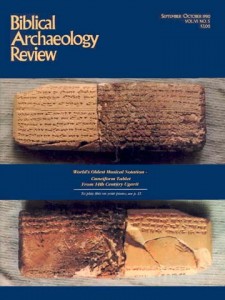“Heard melodies are sweet, but those unheard/Are sweeter,” wrote the nineteenth century poet John Keats. In many ways archaeology is the antithesis to this poetic sentiment: the archaeologist’s job is to animate the silent remains he uncovers. This is exactly what Professors Anne Draffkorn Kilmer and Richard L. Crocker of the University of California at Berkeley did when they were given a tablet from ancient Ugarit to decipher. After collaborating with scholars from all over the world, they deciphered the lyrics and music of “The World’s Oldest Musical Notation.” Today, we can hear this 3500-year-old Hurrian Cult Song played on an ancient replica lyre constructed by Professor Richard Brown, also of the University of California at Berkeley, on the recording, “Sounds From Silence.”
About 300 hundred miles from ancient Ugarit, on the barren heights east of the Dead Sea, archaeologists have been excavating Early Bronze tombs and charnel houses at Bab edh-Dhra and Numeira. Here, and at three other nearby Early Bronze sites, Excavation Directors Walter Rast and R. Thomas Schaub believe they have found the remains of the Five Cities of the Plain including Sodom and Gomorrah which, in the Bible, epitomize the ill-fated path of evil. In “Have Sodom and Gomorrah Been Found?” BAR brings you the first report with full-color illustrations of these astonishing conclusions.
Already a library member? Log in here.
Institution user? Log in with your IP address.

